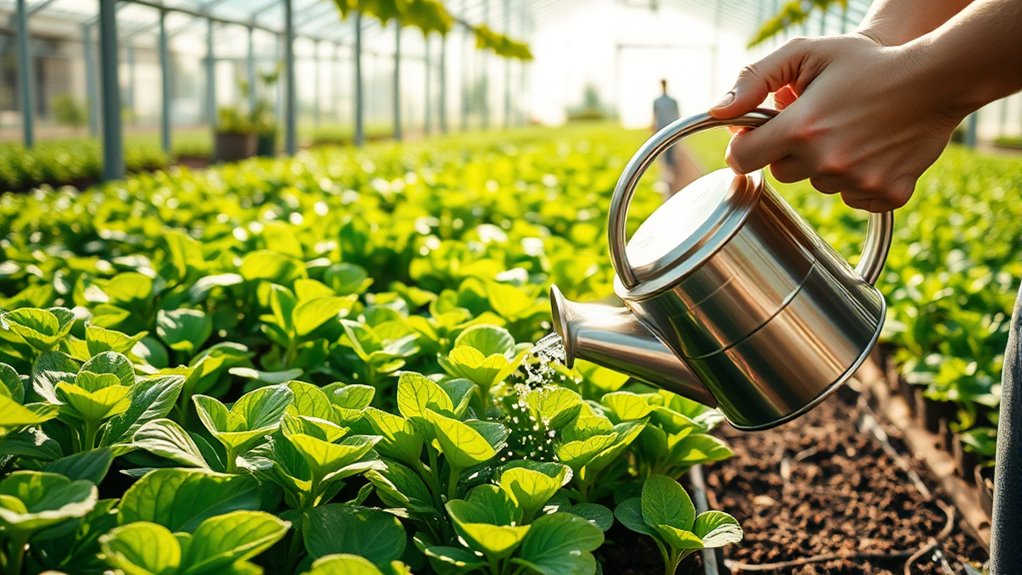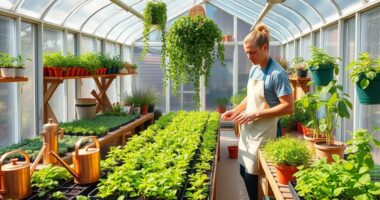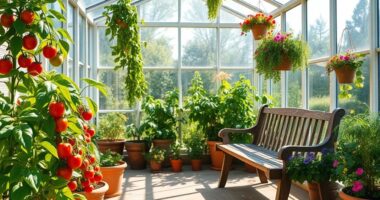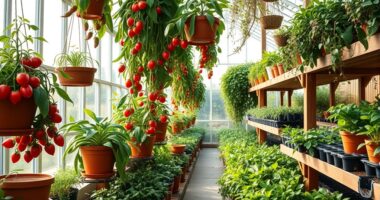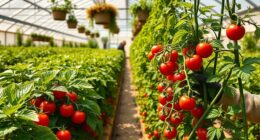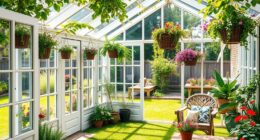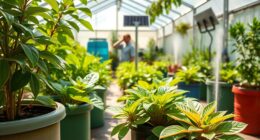To water your greenhouse plants properly, focus on consistently providing the right amount of moisture at the soil level using drip irrigation or soaker hoses. Check soil moisture regularly with a finger test or moisture meter, watering when the soil feels dry a few inches deep. Adjust watering based on environmental conditions like temperature and humidity, and verify your soil drains well to prevent overwatering. For more tips on keeping your plants healthy, keep exploring how to perfect your watering routine.
Key Takeaways
- Use targeted drip irrigation or soaker hoses to deliver water at plant bases, reducing waste and preventing fungal issues.
- Regularly check soil moisture with a meter or finger test and water only when the soil feels dry a few inches below the surface.
- Adjust watering frequency based on environmental conditions like temperature and humidity, increasing in hot, dry weather.
- Ensure soil has good drainage to prevent waterlogging and root rot, and keep foliage dry to minimize disease risks.
- Automate watering schedules with timers for consistent moisture levels, and tailor practices according to soil type and plant needs.
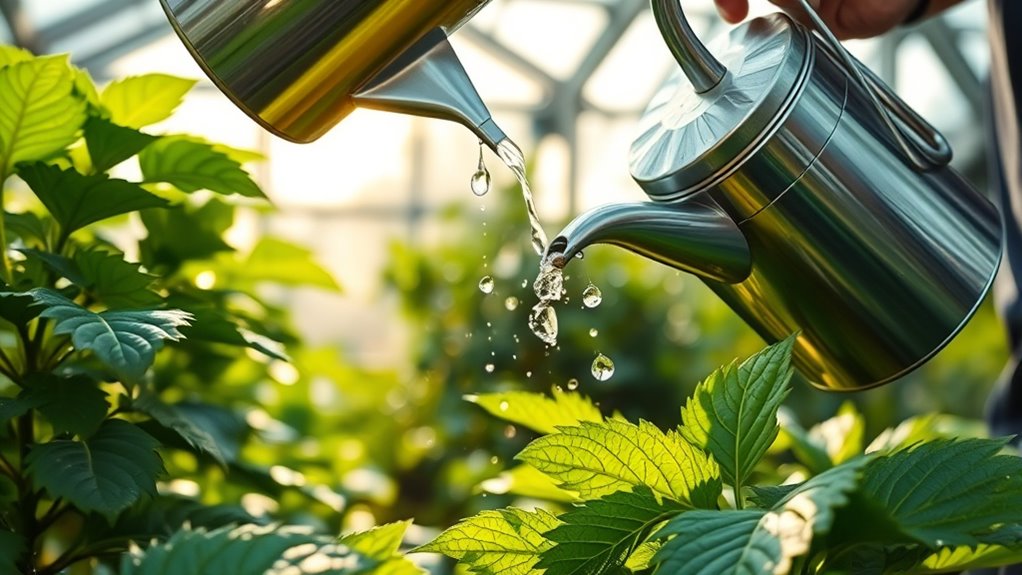
Proper watering is essential for healthy greenhouse plants, as it directly affects their growth and significance. When you water your plants correctly, you ensure they receive the right amount of moisture needed for ideal development. One effective method is drip irrigation, which allows you to deliver water directly to the base of each plant. This targeted approach minimizes waste and helps maintain consistent moisture levels. By using drip irrigation, you can automate the process, reducing the time and effort required while ensuring your plants don’t suffer from overwatering or underwatering.
Moisture monitoring plays a critical role in maintaining proper watering routines. Instead of relying on guesswork, you should regularly check the soil moisture levels to determine when your plants need water. This can be done with moisture meters or simple finger tests. When the soil feels dry a few inches below the surface, it’s time to water. Conversely, if it’s still moist, hold off until the soil dries out slightly. Consistent moisture monitoring prevents you from watering too frequently, which can lead to root rot, or too infrequently, which can stress your plants and hinder growth. Using soil type knowledge can help you adjust watering practices based on your specific soil’s water retention capacity.
To maximize watering, set a schedule that aligns with your greenhouse’s environmental conditions. Factors like temperature, humidity, and plant type influence how much water is needed. During hot, dry days, your plants will require more frequent watering, while cooler days might mean less. Drip irrigation systems can be programmed to deliver precise amounts of water at specific times, ensuring your plants stay consistently hydrated without overdoing it. Incorporate moisture monitoring into this routine by checking the soil regularly, adjusting your watering schedule as needed.
Another key point is to avoid watering from above, as it can promote fungal diseases and pest problems. Instead, aim to water at the soil level using drip emitters or soaker hoses. This keeps the foliage dry and reduces the risk of disease. Also, consider the soil composition; well-draining soil helps prevent waterlogging, which can suffocate roots and cause other issues. If your soil retains too much moisture, improve drainage or adjust your watering habits accordingly. Understanding the water retention capacity of your soil can help you tailor your watering practices more effectively. This knowledge is especially important since security systems can assist in monitoring environmental conditions remotely, ensuring your greenhouse environment remains optimal.
Additionally, understanding the weight of pinball machines can help you better plan for transportation and installation, especially in a greenhouse setting where space and handling are considerations. Ultimately, mastering proper watering involves a combination of efficient techniques like drip irrigation and diligent moisture monitoring. When you pay close attention to your plants’ needs and use the right tools, you’ll create an environment where they can thrive. Consistency and observation are key. By watering thoughtfully, you’ll promote healthy growth, stronger plants, and a more productive greenhouse.
Frequently Asked Questions
How Often Should I Water Different Types of Greenhouse Plants?
When considering how often to water your greenhouse plants, you need a tailored watering schedule that suits each type for ideal plant hydration. Some plants prefer consistently moist soil, so water them daily, while others like succulents need infrequent, deep watering. Keep an eye on soil moisture and adjust accordingly. Proper watering ensures your plants stay healthy and vibrant, preventing overwatering or dehydration.
What Is the Best Time of Day to Water Greenhouse Plants?
The best time of day to water greenhouse plants can feel like finding a needle in a haystack, but it’s vital for their health. You should aim for the early morning as your ideal watering time. This allows plants to absorb moisture before the heat of the day, reducing evaporation. Stick to a consistent watering schedule, and you’ll see your plants thrive with less risk of disease or stress.
How Can I Tell if My Plants Are Overwatered or Underwatered?
You can tell if your plants are overwatered or underwatered by observing their symptoms. If your plants are wilting despite moist soil, they might be overwatered, risking root rot. Conversely, if the soil feels dry and your plants are wilting, they’re likely underwatered. Check the leaves and soil regularly—healthy plants bounce back quickly, but persistent wilting or soggy roots indicate watering issues.
Do Humidity Levels Affect How I Should Water My Greenhouse Plants?
Did you know that humidity impact can change how often you should water your greenhouse plants? When humidity is high, evaporation slows, so plants need less frequent watering. Conversely, low humidity increases drying, requiring you to water more often. Monitoring your greenhouse’s humidity levels helps you adjust watering frequency, preventing over- or underwatering. Stay attentive to humidity, and you’ll keep your plants healthy and thriving.
What Tools Are Best for Watering Greenhouse Plants Efficiently?
When choosing tools for watering greenhouse plants efficiently, consider using watering cans for targeted, gentle watering, especially for delicate plants. Drip emitters are excellent for consistent, hands-off watering, helping you save time and reduce waste. Combining these tools allows you to customize watering methods based on plant needs, ensuring proper hydration. Using the right tools keeps your plants healthy, promotes even moisture levels, and simplifies your greenhouse maintenance routine.
Conclusion
Remember, just like a skilled gardener tending to delicate blooms, your careful watering guarantees your greenhouse plants thrive. Think of it as nurturing a secret garden—each drop supporting growth and vitality. When you water wisely, you’re not just quenching roots; you’re cultivating a lush oasis that mirrors the lush landscapes of fairy tales. So, stay attentive, and watch your plants flourish as if touched by a touch of magic. Your green thumb can turn any space into a thriving paradise.
